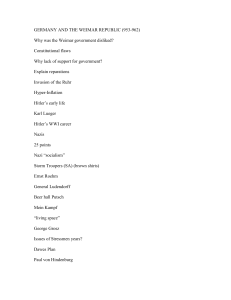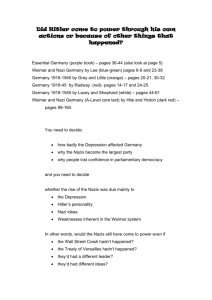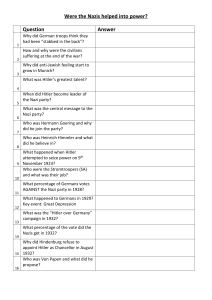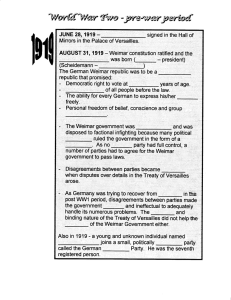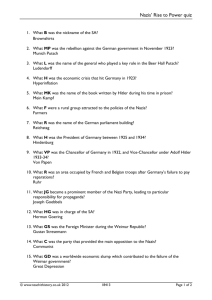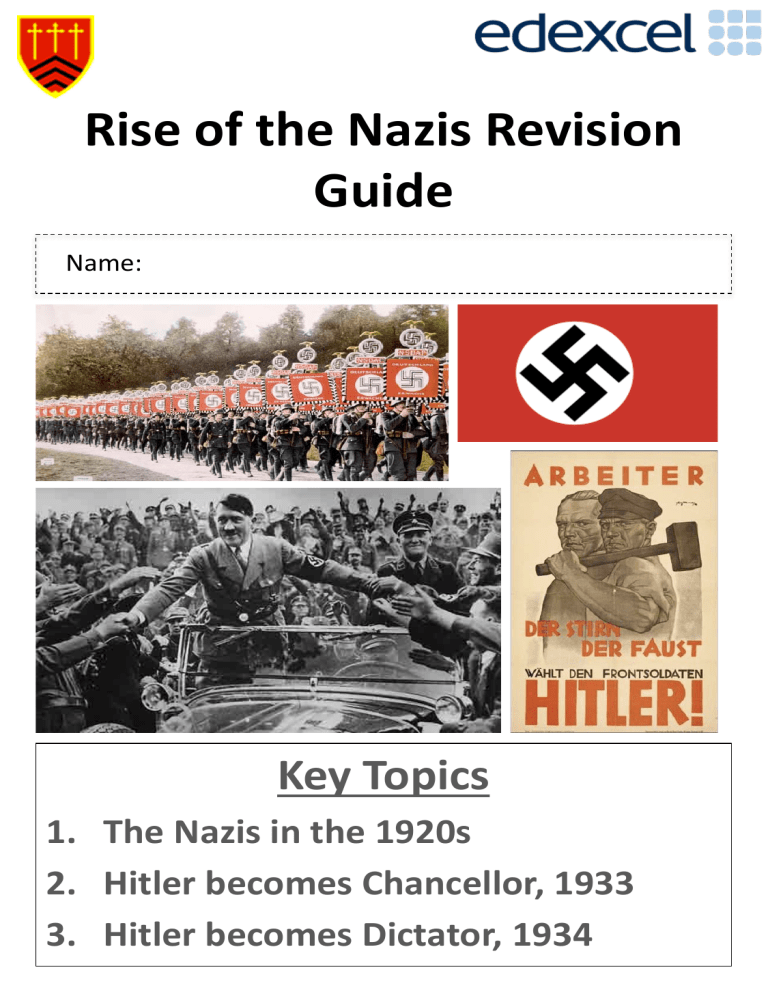
Rise of the Nazis Revision Guide Name: Key Topics 1. The Nazis in the 1920s 2. Hitler becomes Chancellor, 1933 3. Hitler becomes Dictator, 1934 @mrthorntonteach Hitler and the early Nazi Party The roots of the Nazi party start in 1889, with the birth of Adolf Hitler but the political beginnings of the party start in 1919 with the set up of the German Workers Party, the DAP. This party was one of the many new parties that set up in the political chaos after the First World War and it was the joining of Adolf Hitler that changed Germanys future forever. The early life of Hitler Hitler wanted to become an artists but was rejected by the Vienna Art School Hitler was born in Austria in 1889 to an abusive father. In 1913, he moved to Munich and became obsessed with all things German Between 190813, he was homeless and sold paintings Who were the DAP? The German Workers Party (DAP) was set up by Anton Drexler in 1919 in Munich. At first there were only a small group of 50 members Hitler was shocked by Germanys defeat in WWI and blamed the Weimar Republic He fought in the First World War, winning the Iron Cross but was wounded by gas in 1918 In 1919, Hitler begins to spy on the German Workers Party (DAP) but then joins the party, soon taking over. The DAP were national socialists: Nationalists – believed that all policies should should be organised to make the nation stronger Socialists – believed that the country's land, industry and wealth should below to the workers. They also hated the Weimar Republic, Treaty of Versailles and Jews who they blamed for the problems. Hitler and the birth of the Nazi Party 1919-21 1. Hitler is invited to join the party in 1919 after Drexler hears him debating at a DAP meeting (which he was spying on!) 25 Point Plan The 25 point plan was the Nazi manifesto (their policies) it included their beliefs and ideology. The key points included: 2. Hitler becomes Drexler’s right-hand man and in 1920 together they announced the parties 25 Point Programme. 1.The creation of a strong central government 3. Hitler's personal appeal and ability as an energetic and passionate speaker along with hatred of the Weimar Republic meant membership grew to 3000 by 1920. 4.Increase pensions for the elderly 2.The union of all Germans in a Greater Germany 3.Get rid of the Treaty of Versailles. 5.Nationalise industries (government control) 6.Everybody should have a job. 7.Build up Germany's armed forces 4. Hitler suggests the DAP change its name to the National Socialist German Workers’ Party (NSDAP or Nazis for short). They also choose the Swastika as their symbol. 8.Only German races may be members of the nation, no Jews and all other non Germans must leave. 5. In July 1921, Hitler becomes leader of the Nazi Party 10.All citizens should have equal rights and duties. 9.Expand Germany across new territory to feed the people and to settle surplus population (Lebensraum). 11.Every hard-working German to have the chance of higher education. 12.State must protect mothers and infants, stop children working. The 25 Point Programme appealed to many Germans (workers, soldiers, women) especially at a time when the Weimar Republic was in serious trouble. Give two things you can infer from the 25 Point Programme about the NSDAP in the 1920s (4 Marks) @mrthorntonteach Hitler and the early Nazi Party Organisation of the party The role of Sturmabteiling (SA) Hitler made his personal mark on the party by introducing a number of changes: Hitler used the SA (Sturmabteilung), Stormtroopers or Brownshirts as a way to control of the party. • The NSDAP set up a permanent office in Munich They were setup in August 1921 as a paramilitary force who dressed in brownshirts. Many of them SA were ex-soldiers or Freikorps. • They also bought two newspapers the Wolkischer Beobachter ("Peoples observer”) and Der Sturmer, this allowed the Nazis message to spread across Germany The SA paraded in the streets as a show of force. By August 1922, they numbered about 800 and impressed people with a sense of power and organsation. • Hitler carefully selected party leaders for their skills and to help the Nazi image, they included: Rudolf Hess (Hitler's deputy), Hermann Goering (WW1 hero), Julius Streicher (Publisher) and Ernst Rohm (a popular ex army officer) The SA control the crowds at meetings often using violence. They were also sent to attack and beat opposition, like communists. Therefore, the SA strengthened the NSDAP and made Hitler more powerful. • Hitler also made powerful friends such as General Ludendorff, leader of the German Army during WW1 Hitler gains complete control of the NSDAP By the party conference of January 1922, Hitler's control of the NSDAP was complete. He persuaded the members to give up their right to elect their leader. This was the Fuhrerprinzip – where Hitler at the Furher (leader) of the party had complete power and authority over everything. The NSDAP was his party. Hitler’s leadership ensured that Nazi membership grew from about 1,100 in June 1920 to about 55,000 in November 1923. Exam Questions Source D: The pledge of loyalty and obedience taken by members of the SA As a member of the NSDAP, I pledge myself by its storm flag to: • Be always ready to stake like and limb in the struggle for the aims of the movement • Give absolute military obedience to my military superiors and leaders • Bear myself honourable in and out of service Source E: A member of the Nazi Party describing one of Hitler’s speeches in 1922 My critical faculty was swept away. Learning forward as if he were trying to force his inner self into the consciousness of all these thousands, he was holding the masses, and me with them, under a hypnotic spell by the sheet force of his belief….I forgot everything but the ma; then glancing around, I saw that his magnetism was holding these thousands as one. 1. How useful are sources D and E for an enquiry into the early Nazi Party? Explain your answer using Sources D and E and your knowledge of the historical context. (8 marks) Source A: Extracts from the Twenty-Five Point Programme, originally produced by the DAP in February 1920. l We demand the union of all Germans in a Greater Germany. 2 We demand equality of rights for the German people in its dealings with other nations. 3 We demand land and colonies to feed our people and settle our surplus population. 4 Only those of German blood are members of the nation. No Jew may be a member of the nation. 7 We demand that the State's primary duty must be to promote work and the livelihood of its citizens. 9 All citizens shall have equal rights and equal duties. 17 We demand a law to take from the owners any land needed for the common good of the people. 22 We demand... the creation of a people's 25 We demand the creation of a strong central state power for the Reich 2. Give two things you can infer from Source A about the NSDAP in the 1920s (4 marks) I can infer Details in the source that tell me this I can infer Details in the source that tell me this @mrthorntonteach The Munich Putsch, 1923 In November 1923, Hitler launched the Munich Putsch (The Beer Hall Putsch) a violent uprising to overthrow the Weimar Republic and set up Nazi state. It ended in failure with 14 dead Nazis and Hitler in prison, and until 1928 the Nazis struggled to get any support. However, the Munich putsch is seen by historians a significant factor in Hitler’s eventual rise to power. Reasons for the Munich Putsch Events of the Munich Putsch The Munich Putsch happened for a variety of different causes: 8th November 1923 Longer-term causes From 1918 there was a long list of issues that caused anger amongst Germans, such as; the ‘stab in the back’, reparations, the loss of the war and the loss of Germany’s colonies. Also, there was resentment of the Weimar Republic, particularly in areas like Bavaria where the Nazis were based. Local leader Gustav on Kahr shared many of the Nazi views. Medium-term causes From 1921 to 1922, the Nazis were heavily influenced by the Fascists in Italy led by Mussolini (they copied the salute and flags). Mussolini had taken power in Rome by overthrowing the democratic government, perhaps the Nazis could do this too? Hitler with 600 SA entered a beer hall in Munich where the Bavarian government were meeting. At gunpoint, Hitler forced government leaders (Von Kahr, Lossow, and Von Seisser) to support him. Rohm and the SA then took over the local police and army headquarters but not the local army base. When Hitler left Ludendorff, then let the government leaders go, they refused to support the putsch. 9th November 1923 Hitler gather with 1000 SA and 2000 volunteers supporters and marched on Munich town center to declare himself the President of Germany. He hoped the local people would support them, but the did not and neither did the army. The Group was met by state police. Someone opened fire and there was chaos. Ludendorff, Rohm and Streicher were arrested Short-term causes During 1923, Germany was in chaos with hyperinflation and the Ruhr crisis. Hyperinflation in Germany reached its peak and millions of Germans were deeply unhappy. Many saw the Weimar republic as weak and unable to solve people's problems. The time was ripe to exploit these feelings and Hitler decided it was a perfect time to take power. 11th November 1923 Hitler was found hiding at a friends house in a wardrobe and was arrested. 14 Nazis were dead, Hitler dislocated his shoulder and his allies were in jail. The Putsch had failed Consequences of the Munich Putsch In the short term, the putsch was a disaster for the Nazis. In the long term, the putsch could be seen as a success. The uprising had failed due to a lack of support and leading Nazis like Ludendorff, Rohm and Hitler were put on trial in 1924 for treason. 1.Hitler only served 9 months in jail and he used his trial to get national publicity for the Nazis. He spent his testimony attacking the Weimar Republic, the ‘November Criminals, Treaty of Versailles and Jews. • Ludendorff was found not guilty, as a respected exsoldier from WW1 the judge let him off • Hitler was sentenced to 5 years in prison • The Nazi party was banned 2.Hitler used his time in prison to write Mein Kampf (My Struggle) which contained his political ideas and it became the inspiration for the future Nazi party 3.Hitler realised he needed a new strategy – violence would not work, the Nazis must get to power democratically. The Nazis must now win public support to get voted into power. 4.The ban on the NSDAP was lifted in 1925 and the new Nazi party relaunched, getting 32 seats in the election. @mrthorntonteach The ’Lean Years’ 1924-28 The Munich Putsch has proved a political disaster for the Nazi Party - 16 Nazis were killed, the putsch was not supported, Hitler was imprisoned and the Nazi party was banned. Mein Kampf However, Hitler used his time to collect his thoughts in Mein Kampf and plan the reorganisation of the Nazi Party Hitler was released in December 1924, after only 9 months and 2 weeks later the ban on the Nazis was lifted. Mein Kampf became the basis for Nazi party beliefs and policies from 1924, it included the following: 1. Nationalism – He wanted to ‘make Germany great again’ by reversing the Treaty of Versailles buildin up the army, invading communist Russia and conquer lands for the German people. 2. Hitler believed the German (Aryan) race was destined to rule the world, but was at risk from Jews who wanted to weaken Ayrans and take over 3. Socialism –Using the wealth of Germany to benefit the working people 4. Totalitarianism – removing democracy and replacing with one leader 5. Traditional vales – Strong Christian family values with clear gender roles. Relaunch of the party On 27th Feb 1925, Hitler re-launched the Nazi party at Munich Beer Hall where the Munich Putsch failed. 4000 people came to hear him speak. Once the Nazi Party was re-launched, Hitler began to take control once more and began to make changes to the Nazi party and its structure. The reorganisation of the Nazi Party Nazi Organisation The Nazi party was based in Munich, with departments for finance, education and industry. They also raised money from businessmen who supported the Nazis. Germany was split into 35 Gaue (regions) with a local leader, the Gauleiter. Hitler used these to keep control over the party. Leadership of the party At the 1926 Bamburg Conference, Hitler strengthened his position. He beat Josef Goebbels and Gregor Strasser for leadership of the party, Goebbels was made Gauleiter for Berlin as a reward. At Bamburg, Hitler also squashed any splits between the nationalist and socialist parts of the party – he had control over policy. Developing support for the Nazis Goebbels was also put in charge of propaganda. He and Hitler believed that the best way to get the support of the masses was by appealing to peoples their feelings The Nazis targeted wealthy businessmen, farmers, women, soldiers and anyone who hated the Weimar Republic, the Treaty of Versailles and Jews. Promises were made to all groups Ersnt Rohm was removed as leader of the SA as he was seen as a threat The Nazis also set up the German Women’s Order and Hitler Youth to gain women and youth members. By 1929, the Nazi party had over 100,000 members. Hitler also set up the SS (Schutzstaffel or protection squad). These were selected members who worked as Hitler’s personal bodyguard. They waged a propaganda campaign using posters, leaflets, radio and film, and organised rallies. The Lean Years – A lack of success Despite the Hitler's changes, the Nazis were failing where it mattered – votes in the polling booth! In 1928, the Nazis only got 3% of the votes, they were the 7th biggest party in the Reichstag. So why were the Nazis failing to secure more votes? 1. The ‘Golden Years’ - Under Stresemann Germany was economically better off, people had more money and jobs. Therefore they supported extreme parties like the Nazis less. Also, Stresemann improved Germany’s international standing, making the people happier. 2.Ex army general and war hero Hindenburg became President, he was respected and this increased support the Weimar Republic and cut those who were against it. 3.The Nazis struggled to get any support from the working classes (who were the majority), they only got 1% of their votes in Berlin and the Ruhr. IT was very clear, when the economy was strong, few people voted the Nazis. @mrthorntonteach Nazis in the 1920s Exam Questions Using your revision guide, the sources and A4 paper, practice the below exam questions. Remember to use the ‘how to’ guides in the front of this book to help your in your answers. 1. Explain why the Munich Putsch (1923) failed You may use the following in your answer: • the German Army • Bavarian leaders You must also use your own information (12 Marks) 2. Explain why Hitler carried out the Munich Putsch You may use the following in your answer: • Ludendorff • French occupation of the Ruhr You must also use your own information (12 Marks) Using these two boxes to micro-plan your answer to the above questions You only need to plan out your 3-4 paragraphs, and key words/terms you would include in each P1. P1. P2. P2. P3. P3. P4. P4. Interpretation 1 From Weimar and Nazi Germany, F Reynoldson, published in 1996. From 1924 to 1929 the Weimar Republic was much stronger than it had been just after the war. Led by Stresemann in the Reichstag, the different parties managed to work together. The extreme parties such as the Nazis gained fewer seats in the elections. The German people were better off and more contented. The Weimar Republic looked safe Interpretation 2 From Weimar and Nazi Germany, E. Wimlott, published in 1997 German prosperity was built on quicksand foundations The Weimar economy was dependent upon high-interest American loans, which usually had to be repaid or renewed within three months. In times of depression, US moneylenders could demand repayment. Moreover, unemployment never fell below 1.3 million. Although big business grew in the 1920s, small firms struggled and many went bankrupt. 2. Study interpretations 1 and 2. They give different views about the extent of German recovery in the years 1924-29 . What is the main difference between these views? Explain your answer using details from both interpretations. 3. Suggest one reason why Interpretations 1 and 2 give different views about the extent of German recovery in the years 1924-29. 4. How far do you agree with interpretation 2 about the recovery of Germany 1924-29 . Explain your answer, using both interpretations and your own knowledge of the historical context. (16 Marks) @mrthorntonteach How did Hitler become Chancellor in 1933? 1. The Depression In October 1929, Wall Street in America crashed. As a result US banks lost billions of dollars, businesses and banks shut down causing a world wide depression which spread to Germany. Firstly the US stopped lending money to Germany and demanded all the loans be repaid. This caused serious problems within Germany. German businesses The German Government They were forced to pay back their loans and now received no investments from US banks. Industrial production dropped 40% by 1932 and wages dropped 15% The government refused to print more money, so Chancellor Bruning decided to raise taxes and cut unemployment benefits. As a result businessmen lost money and had to fire workers and close their factories and companies causing bankruptcy. They also struggled to agree on how to fix the economy, so nothing happened. The German people It led to mass unemployment of workers , 3 million workers in 1930 then 6 million by 1932 The farmers, the middle classes and businessmen lost their savings, businesses and went bankrupt With no work, raised taxes and benefits slashed the German people suffered terrible poverty How did the Depression help the Nazis? The depression caused more hatred towards the Weimar Republic who made problems worse. As a result the people began to vote for extreme parties like the communists and Nazis. The Nazis used the depression to get more votes as they promised to fix the economy. In speeches Hitler promised ‘bread and work’ to all workers in Germany, whilst they opened soup kitchens for the poor. There is a direct link between the depression and Nazi votes, as unemployment rose so did Nazi votes. Year Unemployed Nazi Seats in the Reichstag 1930 3 million 107 Nov 1932 6 million 230 July 1932 5 million 196 1933 4.8 million 288 The depression was a gift to the Nazis, it helped them finally get into power. 2. The Fear of Communism The depression also led to a rise of support for the communist party (KPD) from the working classes. They felt they were their best hope. By 1932 they had 100 members of parliament. Hitler and the Nazis hated communism (they thought it was linked to a Jewish conspiracy to destroy Germany) and they vowed to destroy communism As communist support grew, this worried the middle and upper classes and German businessmen . They were frightened of a Communist revolution as they would suffer. So they began to support the Nazis giving them votes and money. The Nazis used the SA to fight the communists in the streets and disrupt meetings. 3. The Weaknesses of the Weimar Republic Many people hated the Weimar Republic and they never forgave them for the loss of WW1, the ‘stab in the back’, the Treaty of Versailles and the Depression which they failed to fix. Between 1919-1933, there were 20 different coalition government who constantly fell out, this meant nothing got done so President Hindenburg had to keep using Article 48 to pass every law. This made the Weimar Republic look weak and useless. This helped increase votes for the Nazis as Hitler who promised a strong government like they previous had in the Weimar Republic. @mrthorntonteach How did Hitler become Chancellor in 1933? 4. The Organisation of the Nazis and the Role of Hitler Organisation The Nazis were very organised, they set up Nazi offices all over Germany to recruit more voters and got financial support from wealthy businessmen and industrialists like Krupp and Bosch. They even set up groups like the Hitler Youth to reach the young of Germany. The SA Role of Hitler The SA made the Nazis seem organised, disciplined and reliable. In a time of the depression, they looked strong. Hitler was shown as the strong, decisive leader that Germany needed. He was a veteran, worker and appealed to all Germans. Germany propaganda called Hitler ‘our last hope’ The SA were also used disrupt other parties like the communists and openly fought with them on the streets. In one clash 18 were killed Hitler was an excellent orator (speaker) who drew large crowds, he would fly around 6 cities a day, delivering simple but powerful speeches. In the 1932 Presidential election, Hitler received 11 million votes (30%) which highlighted how the people saw Hitler as a future leader of Germany. Promises Propaganda Josef Goebbels used modern technology such as radios, films, and loudspeakers alongside posters and leaflets. They owned 140 newspapers! The Nazis promised something to everyone, it is what gained them votes. They had simple messages like ‘One People, One Nation, One Leader’ He also attacked the Weimar government and blamed Jews for the problems. Specific groups were targeted with propaganda: • Big Business: Promised Hitler was their best protection from communism • Working Class: They promised ‘Work and Bread’ and a return to traditional German values • Middle Class: Hitler was the strong leader to bring economic recovery, he would protect them from communism and he would overturn the changed made under the Weimar Republic • Farmers: Promised protection from communism and taking land from Jews Propaganda targeted specific groups; workers, farmers and businessmen. Goebbels was able to make sure the Nazi message was heard everywhere, locally and nationally. The message was ‘unity’, bringing Germany together again Above all Hitler promised to make Germany great again by restoring law and order, destroying communism, abolishing the Treaty of Versailles and fixing the depression. 5. Hitler becomes chancellor in 1933 May 1932 July 1932 Nov 1932 • In early 1932, the Nazi were far from being in power but thing began to change. •Bruning resigns after losing support, so Hindenburg makes Franz von Papen chancellor •The Nazis get their most votes, 240 seats (38%) •However, Hindenburg refuses to make Hitler Chancellor as he despises him, calling him a ‘jumped up corporal’ • Von Papen loses support and quits as Chancellor • The Nazis drop to 196 votes in the election, but are still the largest party 1932 •Schleicher is persuaded to become Chancellor, but he has no power or support in the Reichstag •Von Papen persuades Hindenburg to sack Schliecher who wants to use the army to take power. •They foolishly think they can make Hitler Chancellor whilst controlling him . Jan 1933 •On 30th January 1933, Hitler is appointed Chancellor of Germany •The Nazis have got into power legally and democratically Dec @mrthorntonteach How did Hitler become Dictator in 1934? 1, The Reichstag Fire, 27th Feb 1933 On February 27th 1933, the Reichstag (German parliament) was burnt down with a communist Van Der Lubbe arrested at the scene (There are rumours the Nazis did it.) As Hitler had been warning of a communist plot to overthrow the government, the fire was the ‘proof’ he needed to show that communists want to destroy Germany. This led to The Nazis arrest over 4000 communists and ban the communist party. They shut down political opponents meetings and newspapers, whilst thousands are sent to concentration camps This gave Hitler more power because… This reduces Nazi political opposition. Hitler persuaded Hindenburg to sign ‘The Reichstag Decree’, also called the Emergency Decree, which gave Hitler many powers. 1. The laws allow the Nazi controlled police to arrest anyone suspected of opposing the government, ban meetings, close newspapers and hold people without trial. 2. German had now become a police state 2. The Enabling Act, 1933 The March 1933 Election In the March 1933 election, the Nazis get their their best ever result (44%) However, it still failed to give the Nazis an overall majority. This persuaded Hitler to pass the Enabling Act, as he wanted to end democracy. April 1933, People’s Courts Hitler sets up the ‘People’s Courts’ to give him control over the justice system and laws. Judges are made to swear an oath of loyalty to Hitler. Jan, 1934, Local Government Hitler abolishes local Lander parliaments and replaced them with a governor (Gauleiter) who directly serves Hitler. 23rd On March 1933, the Reichstag passes Enabling Act which gives Hitler power to pass any law without approval of the Reichstag. He immediately begins to use these powers to gain more control over Germany. May 1933, Trade Unions banned The banning of Trade Unions removed workers rights and brings them under his control. July 1933, Political parties banned Hitler bans all political parties except the Nazis, the leaders of the other parties are imprisoned. This gives Hitler total control. Democracy is over Hitler has been given complete power over the government and laws, which effectively makes Germany a dictatorship under Hitler. The Enabling Act ends all democracy in Germany 3. The Night of the Long Knives, 1934 Hitler begins to fear from threats in his own party, the SA (Brownshirts) The SA are a force of 3 million men under ex soldier Ernst Rohm. They were originally used to intimidate Nazi opposition and were important in Hitler coming to power in 1933. Hitler believed Rohm wants to overthrow him, whilst the army despised the power the SA had and Himmler and the SS hated Rohm and wanted to replace the SA with the SS. In 1934, after encouragement from the Army and SS, Hitler orders the arrest of SA ‘traitors’ On the night of 30th June 1934, the SS arrest 400 SA leaders, some are imprisoned and others are executed including Ernst Rohm. Hitler also uses the opportunity to take out old political opponents, such as exchancellor Von Papen. Hitler had now eradicated all threats within his party, the army were now more supportive and it showed Hitler agreed to murder to keep power. 4. The Death of Hindenburg On 2nd August 1934, President Hindenburg dies Within hours, Hitler combines the role of President with Chancellor to create a new title ‘Fuhrer of the Third Reich’ He also forced the army to swear a unconditional oath of loyalty and obedience to him. This bring them under Hitlers control. Hitler is now the complete ruler of Germany @mrthorntonteach Hitler takes power Exam Questions Using your revision guide, the sources and A4 paper, practice the below exam questions. Remember to use the ‘how to’ guides in the front of this book to help your in your answers. 1. Explain why Hitler was able to become Chancellor in January 1933 You may use the following in your answer: • The Depression • The role of Hitler You must also use your own information (12 Marks) 2. Explain why Hitler was able to become the dictator of Germany by 1934. You may use the following in your answer: • The Night of the Long Knives • The Reichstag FIre You must also use your own information (12 Marks) Using these two boxes to micro-plan your answer to the above questions Micro plan your 3-4 paragraphs, and key words/terms you would include in each P1. P1. P2. P2. P3. P3. P4. P4.

